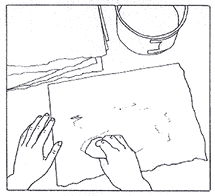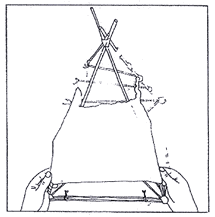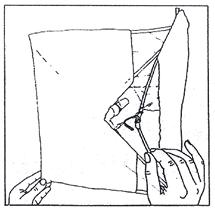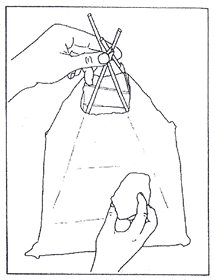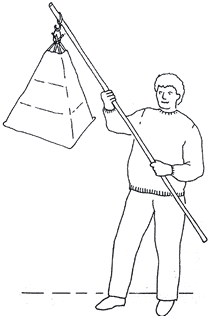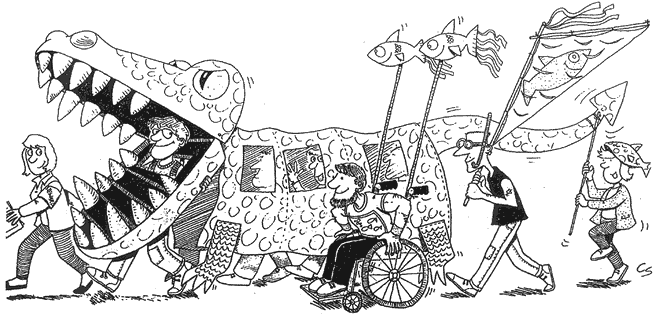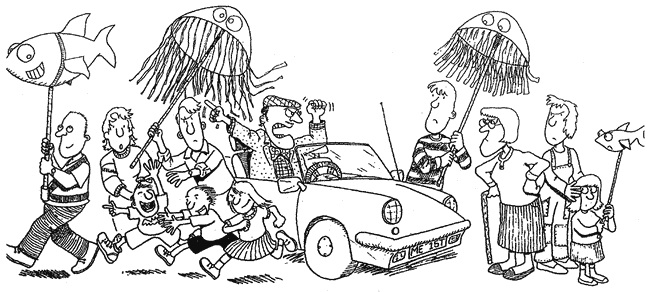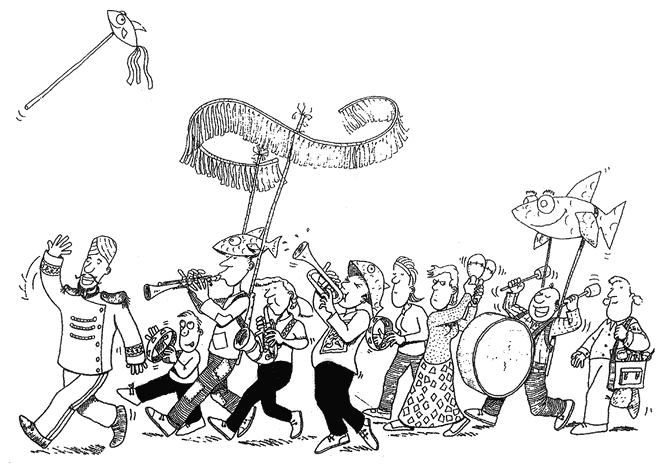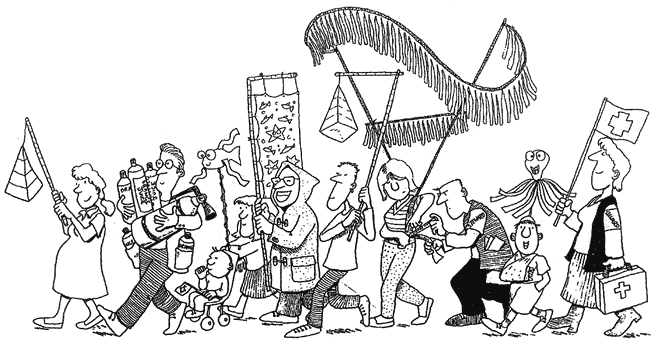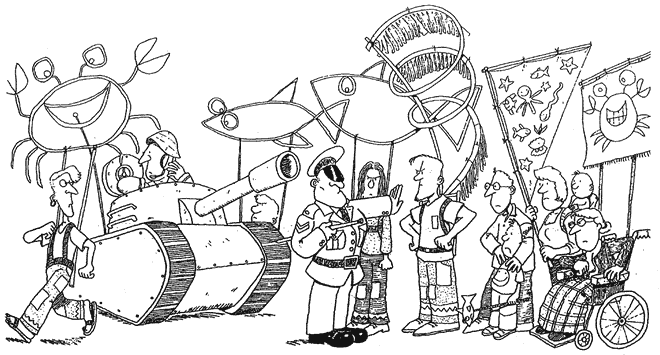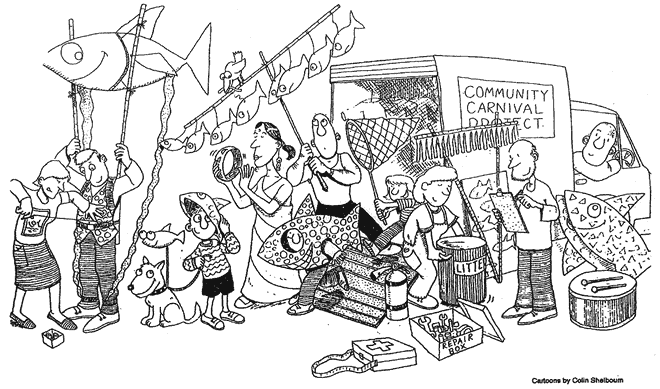| Lanterns
1 Introduction |
|
| This
pack is designed to help you create hand made lanterns. Starting with
a framework of willow sticks (withies), the basic shape is covered with
tissue paper soaked in glue and lit internally by a candle. The lantern
can be carried on a bamboo stick outdoors, as part of a procession.
If you have not made a lantern before, we would strongly urge you to
try some of the simple shapes first, before embarking on anything more
ambitious. Lanterns designed for display or indoor use must be lit electrically
– either battery or mains, maybe with a loom of small bulbs wired
up. |
Inside you will find a list of all the materials you will need, and detailed instructions on how to make a lantern. We also show you how to create and manage a lantern procession, including suggestions of themes you might use. Colour needs to be carefully thought about. A mass of simple forms looks lovely with just the natural amber glow of the flame. The simplest way to add colour is to make a collage of coloured tissue paper. Specialist paints can be used but they are expensive and can lead to complications. They must be translucent; not all pigments are, so you must be sure to do your own tests. Silhouettes from cut paper are an effective and cheap way of adding detail. Emulsion paint is hopeless; when the lantern is lit it will look black. Once you are familiar with making simple lanterns, you can try more ambitious sculptural forms, using bamboo for strength. Large lanterns may be carried on a framework by two or four people, and lit by hurricane lamps. Joints should be drilled and wired, then bound with strong tape or strips of cloth and glue. White cloth (natural fibre) makes a stronger covering. Fabric dyes can be sprayed or painted on. Figurative lanterns can be constructed on a “back pack” – an old rucksack frame will do – and worn by a robust person! Remember, triangles are vital for stability in construction, foam rubber padding for comfort. For more detailed information about lantern making, please refer to the Welfare State International handbook, Engineers of the Imagination, in the “how to do it” section. |
Reg. Charity No. 265461 |
| Lanterns
2
|
|
|
Reg. Charity No. 265461 |
| Lanterns
3 |
|
|
Reg. Charity No. 265461 |
|
|
COVERING
THE LANTERN |
WARNING: DON’T WEAR A SHELL SUIT OR NYLON ANORAK |
Reg. Charity No. 265461 |
| Lanterns 5 Materials Withies – Willow Sticks |
|
| J
Burdekins Ltd. |
P.H
Coate & Sons |
| Strong
Tissue Paper – “Wet Strength” |
|
| All the following are available from D.I.Y or hardware stores:
|
|
Reg. Charity No. 265461 |
Lanterns 6
| DESIGNING YOUR LANTERN Anything can lend itself to becoming a reason for having a lantern procession, whether you are celebrating, protesting, or simply feel like organising a procession! One of the greatest difficulties can often be finding the motivation to begin. Possible examples are:
More “open” topics could be:
It is good to be particular - our community, our district, town, village etc. People could make images of where they live – their block of flats, house, the house of their dreams – or well known landmarks, such as the bridge, the Town Hall Clock, the brewery; or the products of their local industry – silencers, nuts and bolts, helicopters…..in other words absolutely anything can be used as the basis for a lantern or a procession. ... |
Explore all angles of your theme, for example: The Sea – Fish, Birds, Boats, Lobster Pots, jellyfish, Plankton, Pollution, Lighthouses, buoys
Anniversary of the Tolpuddle Martyrs – convicts in black and white stripes, a convict ship in full sail, justice balancing the scales, Australian animals, the tree where the trial took place….. Charles Babbage, son of Totnes – look at all the things he invented – computer, cowcatcher, maritime lights, stomach pump, codes, cyphers, locks, keys etc.. an effigy of the man, his school, his house…. Whatever the theme, make sure you are well informed about all the background details, so that you can have as wide a variety of lanterns as possible. Anything can be represented by a lantern and you want your procession to look as varied and interesting as possible. |
Reg. Charity No. 265461 |
Lanterns 7
| THE PROCESSION PREPARATION DESIGNING
YOUR PROCESSION |
Take it to the assembly point. Insist on the plan and have your stewards take charge. No-one overtakes the front. Think about where you put the band – not necessarily at the front. Those at the back can feel forgotten and dispirited; in the middle works well. If you’ve got an acoustic band – negotiate carefully with the organizers for a good position in the procession. Make sure you are not behind the truck with the rock band or the DJ with the big PA. Put a strong image at the front, people will hear and see you coming. Height is everything. Light structures/banners that move, that are comfortable to carry can be handled in the wind. Let the wind go through, don’t fight it. Cut scollops in your banner – you will still read it. Leave gaps in large structures. Look at traditional belts for carrying poles. |
|
|
|
Reg. Charity No. 265461 |
Lanterns 8
|
Arriving Let participants know the exact time and place to assemble and what to wear. It is best to give out information sheets, with a map, well in advance. Include the finish time (take spare copies for the event itself). Departing |
this may not be possible, so you need to get your transport there quickly. Work out your own plan, in advance, (including who has the keys!) TRAFFIC
CONTROL Watch out for excited, unescorted children running ahead on the road. Beware of unsympathetic, impatient drivers being thoughtless and unwilling to wait till you pass. |
|
|
|
Reg. Charity No. 265461 |
Lanterns 9
|
MANAGING
A PROCESSION In the band, put a bandleader at the front. Usually bass drums at the back keeping time, brass at the front, hand held percussion in between. There is a case for putting trombones at the front. Brass musicians are quite vulnerable when playing in a throng of excited youngsters. You must always have at least a couple of people to accompany them. In your practices, arrange an order and stick to it, |
so musicians know who they are next to, who they are behind. Practice moving and keeping in tight formation. In the excitement or tension of the day, attention wanders and you can look a mess, but encourage people to keep each other in formation. You cannot expect musicians to be in charge of the route or to make decisions about crossing the road. They are there to play music to the best of their abilities. Stewards must take these responsibilities. Aim for a good finish – in your practices, make it clear you keep going/performing/playing until the agreed dispersal point (ideally out of sight). People are watching from behind as you retreat into the distance. Disintegration leaves a bad impression. |
|
|
|
|
Reg. Charity No. 265461 |
Lanterns 10
| STEWARDS If you are doing your job well and have created a carnival mood, people will want to join in on the day – tucking them in behind the band is a good idea – don’t let them break up the formation. Stewards need to be friendly and patient but firm. DANGERS |
The front should slow down, stop and wait for others to catch up. Pace is generally dictated by the band – there is one comfortable pace for the bass drum player etc. and that usually suits the whole thing. Wheeled structures also have difficulties of their own with kerbs, gateways etc. Mixing motorised floats with walking/dancing is not to be recommended. (The police will advise on safe spacing). A vehicle travelling slowly throws out more fumes, making a noise and is less flexible than wheeled structures that can be pushed. Mix these elements with greater care, particularly at night. There is a risk of serious accident. For large processions and lantern processions, it is a good idea to inform the local fire brigade and if possible enlist the St. John Ambulance Brigade. |
|
|
|
Reg. Charity No. 265461 |
Lanterns 11
| WHAT IF……? Someone sprains their ankle….they drop out, a steward or parent stays with them, while another goes to get transport – or request help from the first aid authorities. Someone wants the toilet…although you will have drawn people’s attention to the nearest ones to your arrival point, most cafes, pubs, garages are helpful to people in costumes. Someone does not turn up…you can always leave some costumes in the van. Someone’s friend who turned up might be a good risk, but be sure to explain the extent of the commitment. A musician does not turn up…then manage without the part. Last minute changes can panic your band if they are beginners. It’s a wise policy to double up on each section in case this happens. Your music may not be as rich, but it will be confidently played. |
There’s a funeral or road accident…stop playing, quietly walk past to a suitable distance before starting again. Be sensitive to normal everyday life that is happening. At a show you find yourself alongside the display of guns for kids to play on, or at the police dog display…then it shows you did not do your homework properly. Many local festivals and shows are dominated by military recruitment drives in the name of entertainment. You may wish to check this out with the organisers in advance and decide your own policy. THE
WEATHER |
|
|
|
Reg. Charity No. 265461 |
Lanterns 12
| PACKING THE VAN Costumes and hats. Racks or hangers, bags for costumes clearly labelled which can then contain the real clothes people will take off when they get into costumes. No black bin liners to pack important pieces of costume – tragedies have occurred when several weeks work has been thrown out with the garbage. Repair kit: stapler, wire & pliers, string and scissors, safety pins, tape for straps, gaffer tape. |
Lantern Processions: spare candles, tapers, matches distributed among stewards. Health and Safety: first aid kits (portable), fire extinguishers and wet blankets (for any fire imagery) to be carried by stewards. One of each per 50 people. Musical Instruments: drums, box of small percussion. Case for sticks and beaters. Rubbish bin or bag. |
|
|
|
Reg. Charity No. 265461 |
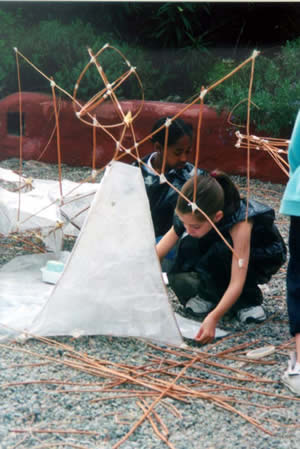
 2.
Cut 4 withies the same length for the base.
2.
Cut 4 withies the same length for the base. 3. Join
them at the corners with masking tape.
3. Join
them at the corners with masking tape. 4. Add 2
diagonals.
4. Add 2
diagonals.





 11. Make a simple wire hook
to close the door.
11. Make a simple wire hook
to close the door. 12.
Use one piece of wire (approx. 1 metre long). First, twist one end of
the wire round the candle……..
12.
Use one piece of wire (approx. 1 metre long). First, twist one end of
the wire round the candle……..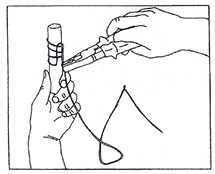 13.
and loop it back on itself.
13.
and loop it back on itself.
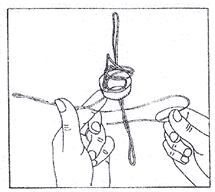
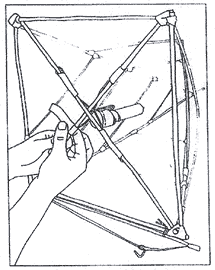

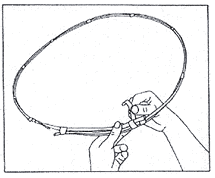
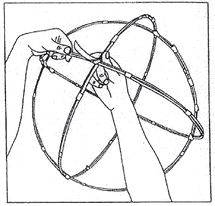
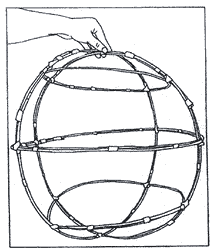
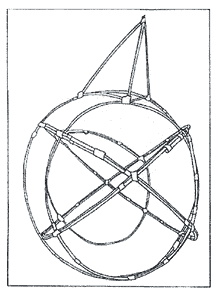 21. This is a very strong
sphere which you can turn into a face, an animal, a bird…….by
adding features. (If necessary add diagonals near the bottom to support
the candle holder). REMEMBER THERE MUST BE 12” CLEAR ABOVE THE
FLAME.
21. This is a very strong
sphere which you can turn into a face, an animal, a bird…….by
adding features. (If necessary add diagonals near the bottom to support
the candle holder). REMEMBER THERE MUST BE 12” CLEAR ABOVE THE
FLAME. 22.
Make a sheaf of 6 withies. Tape at the bottom and near the top.
22.
Make a sheaf of 6 withies. Tape at the bottom and near the top.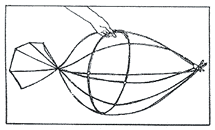 23.
Add a circle and it becomes a fish. Work the thin end into a tail.
23.
Add a circle and it becomes a fish. Work the thin end into a tail.
